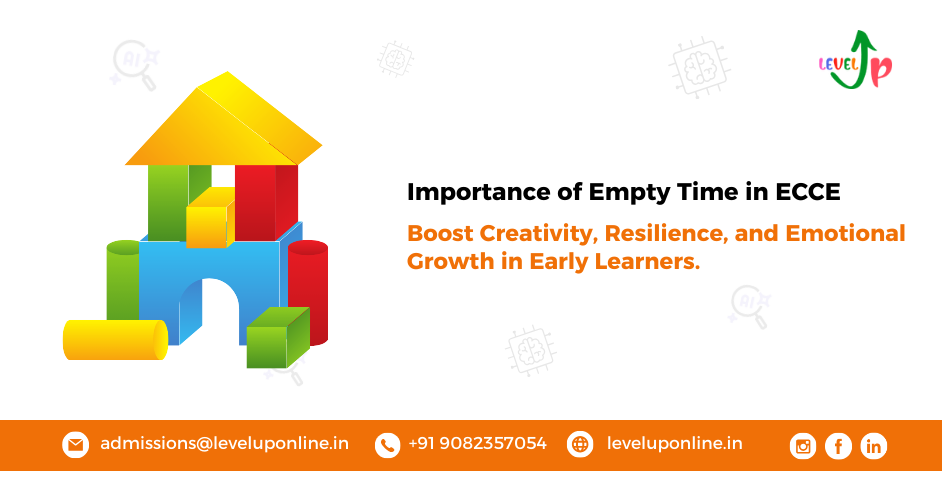Introduction
We live in a world where children’s days are packed with structured lessons, screen time, enrichment classes, and endless stimulation. Silence or slowness feels suspicious. Boredom, we assume, is the enemy.
But what if it’s exactly what young children need?
In the context of early childhood care and education (ECCE), educators and developmental psychologists are rethinking the role of “doing nothing.” More specifically, they are emphasizing the importance of empty time in ECCE—time when a child is free to think, wander, imagine, and simply be.
Let’s dive into why these quiet, unstructured moments may be some of the most essential ingredients in early learning.
The Problem With Over-Scheduling Childhood
In an attempt to give our children “the best,” we sometimes give them too much. Every hour of their day becomes scheduled: phonics class, storytime, dance practice, STEM activities, and maybe even digital games “to boost brain power.”
But this leaves very little space for self-direction.
The importance of empty time in ECCE lies in creating balance. Structured activities teach discipline, yes. But it’s the unstructured, open-ended time that teaches children to explore, reflect, and create from within.
Boredom: A Hidden Catalyst for Creativity
When children say “I’m bored,” it signals an unmet need. But that need is not always for entertainment—it’s for engagement. And the best engagement often comes from within the child.
When we honor the importance of empty time in ECCE, we create space for:
- Imaginative role play
- Inventing games or stories
- Turning ordinary objects into new creations
For instance, a child with nothing but a stick and some leaves may end up creating an entire world. That’s creativity in its rawest, most powerful form—something that only grows when children are left to wonder and invent.
Problem-Solving Thrives Without Instructions
Children today often rely on adult-led solutions. But what happens when they don’t have a ready-made toy or a teacher guiding every move?
They think.
They try.
They struggle—and they figure it out.
This is the heart of the importance of empty time in ECCE. A child faced with “empty” time must make choices, test ideas, face small failures, and adapt. It’s the birthplace of real-world problem-solving, which is critical for both academic and social success.
Fostering Independence and Self-Discovery
A child left alone with their thoughts learns to listen inwardly. They ask themselves:
- What do I feel like doing?
- What can I make out of this?
- What would be fun?
In doing so, they begin to understand themselves—not just as learners but as creators. This is an often overlooked benefit of the importance of empty time in ECCE: it builds a child’s internal compass, helping them discover their preferences, curiosities, and abilities without adult intervention.
Emotional Growth Through Boredom
It’s not just the brain that benefits—so does the heart.
Children who have time to sit with boredom experience a range of emotions: restlessness, frustration, curiosity, calm. Learning to ride these emotional waves, without immediate distraction, builds resilience and emotional intelligence.
In fact, the importance of empty time in ECCE also lies in helping children:
- Manage delayed gratification
- Tolerate uncertainty
- Find comfort in solitude
These emotional muscles serve them well not only in school but throughout life.
The Role of Educators and Parents: Less Can Be More
So how can we as adults support this process without overstepping?
Embracing the importance of empty time in ECCE doesn’t mean doing nothing. It means intentionally allowing space for self-guided exploration within safe, nurturing environments.
Here’s how:
1. Build “Boredom Time” into the Day
Include open-ended play time in daily routines—time that is screen-free and agenda-free.
2. Offer Open-Ended Materials
Instead of one-use toys, provide things like blocks, scarves, cardboard boxes, and loose parts that children can manipulate in countless ways.
3. Be a Quiet Observer
Resist the urge to jump in with suggestions. Watch and listen. Offer support only if truly needed.
4. Encourage Reflection
After periods of unstructured play, invite children to talk about what they created, imagined, or explored. This helps them recognize the value of their own thinking.
Real-Life ECCE Example: The Power of Stillness
At a LevelUp partner preschool in Mumbai, a weekly “Quiet Play Hour” was introduced. No toys. No storybooks. No screens. Just children, simple objects, and silence.
At first, it was chaos.
But by the third week, something shifted. Children began:
- Building forts from chairs and dupattas
- Creating puppet shows from socks
- Drawing elaborate murals with chalk on the floor
The teachers reported higher levels of engagement, peer collaboration, and problem-solving than they’d seen in structured activities. This simple experiment brought to life the importance of empty time in ECCE—showing that children, when trusted with silence, rise to the occasion.
Long-Term Benefits: Beyond the Early Years
The impact of honoring empty time doesn’t stop at age five. Children who grow up with space to explore on their own tend to:
- Be more adaptable
- Show higher self-motivation
- Handle stress better
- Engage in deeper, more imaginative thinking
In a world that increasingly values innovation and emotional intelligence, these traits are essential. And they are nurtured early—during the “nothingness” we often rush to eliminate.
Conclusion: Let the Silence Speak
The importance of empty time in ECCE reminds us that not all learning happens through lessons. Some of the richest growth comes in stillness, in wandering thoughts, and in the slow unfolding of a child’s own ideas.
So the next time you hear, “I’m bored,” take a pause. Don’t rush to fill the gap. Instead, create the space—and watch the child rise to meet it.
Because boredom isn’t the enemy. It’s the invitation.


